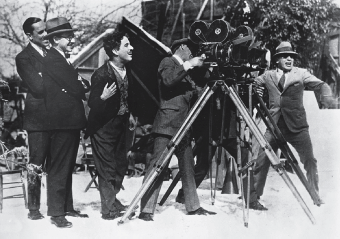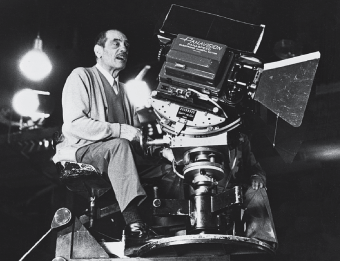Movies and Film: The Directors
The Directors
Now to the directors themselves. We've tried to be inclusive by creating categories that ensure we won't pick the same Hollywood films plus Fellini and Bergman that everyone else does. We've also stayed away from contemporary American directors.
Western and Central European Directors
This list is too tough because it is the pool from which most of the great canonical directors come. So we are going to discuss two directors with very different palettes.
Fritz Lang is on this list both because his films are technically innovative and because they cover a huge range of styles and subjects. He worked in both Germany and (after Hitler gained power) the United States. Even if you haven't seen them, you have probably heard of his most famous films: Metropolis (Germany, 1926), M (Germany, 1930), Fury (1936), and Rancho Notorious (1952). His works are incredibly influential. The impossibly tall skyscrapers and airborne urban transports of the futuristic science-fiction film Metropolis have helped determine the look of such films as Blade Runner (1982) and The Fifth Element (France, 1997). As a psycho-killer film, M predates Psycho by 30 years. In subject matter it's actually more edgy than most contemporary slasher films because, though it isn't as graphic, its central character is a child molester/killer.
Lina Wertmuller is on this list in part because she is a woman who has managed to make it in a distinctly male profession. Lina Wertmuller is probably one of the best political satirists of the post-World War II era. Probably her best and most famous film, Swept Away (Italy, 1974) equates political affiliations with particular class roles, which keep switching back and forth in this dark comedy about a love affair between two incredibly obnoxious castaways on an otherwise incredibly idyllic desert island. The Seduction of Mimi (Italy, 1972) similarly satirizes every political stance from the point of view of a poor underdog who is taken advantage of by all of them.
Eastern European Director
Short Cuts
Further, and lest we mistake surrealism for a cute but empty aesthetic, Svankmajer is making films with a political bite, even when it is still dangerous to do so in the Soviet Union. For example, the short film The Death of Stalinism in Bohemia (1990) is ironically titled. The film really asserts the continuing influence of repressive totalitarianism despite official anti-Stalinism.
We've discussed the Soviet formalists of the 1920s. After them, the Czech surrealist school of filmmakers is probably the most interesting aesthetic to come out of what used to be called the "Eastern bloc." Surrealism as an aesthetic within which to make interesting texts died in the West just before World War II. But no one told the Czechs. The most interesting of the Czech surrealists is Jan Svankmajer.
Svankmajer is the only one on our list who works primarily in animation, specifically stop-motion animation and a version of "Claymation." But, unlike Gumby, Mickey Mouse, and Bugs Bunny, his images and stories are not made for children. They are dark and haunting. His Alice (Czech, 1988), a marvelously creepy interpretation of Alice in Wonderland, is the anti-Disney film. Though she never does, you get the feeling that the little girl could really get hurt. The White Rabbit has very sharp teeth, which he gnashes from time to time. Wonderland is filled with sharp and nonchildproof objects—scissors, knitting needles, pins, and so on—that hurt. The Wonderland denizens are almost all incredibly if unaccountably hostile. Unlike the Disney version, this film represents the dark side of childhood: the feeling of helplessness, the need to understand the uncanny, the burgeoning sense of unaccountable cruelty in the world, the dim emergence of a sense of sexuality. Though this film is about childhood, you might want to think twice before showing it to your kids.
Svankmajer has been doing animation for 36 years, and the Czech surrealists have been making films for 40 years, so he was producing well before Americans made The Simpsons, Cool World (1992), Fritz the Cat (1972), and Nightmare Before Christmas (1993). It is unclear how much he overtly influenced these texts, but if Tim Burton did not see any Svankmajer films before dreaming up Nightmare Before Christmas, we would be extremely surprised.
Developing World Director
Though there are several contenders, including such major international figures as Trinh Min-ha (Vietnam), Ousmane Sembene (Senegal), and Carlos Diegues (Brazil), certainly one of the most famous and enduring non-European filmmakers would have to be Satyajit Ray of India. Trained in childhood as an artist, and working in advertising early in his life, Ray had a disparate range of influences. Perhaps most heavily influenced by Italian neorealism, his films are alternately called "realist," "psychologically realist," "regionally realist," and so on. Ray was extremely interested in representing the current political/ideological/social Indian scene through minute examinations of a few characters per film. His Apu trilogy brought Indian film and culture onto the world stage.
Hollywood Director

Chaplin on location shooting The Gold Rush while in tramp regalia.
As with Western Europe, there are just too many auteurs to choose from, so we are going to discuss two. Along with D. W. Griffith and Orson Welles, one of the most innovative and influential directors would have to be Charles Chaplin.
We know with absolute certainty that Charles Chaplin has "stood the test of time" because, in our film classes, students of the twenty-first century still love the films made by a man whose movie career began with the "flickers" in 1914.
Though his films are not technically innovative (like most silent comics who wanted the emphasis to remain on the movement of his body and face, he favored a static camera), Chaplin magnificently exploits the technologies he does use in extremely sophisticated ways.
For example, Chaplin's "little tramp" is heard for the first time in Modern Times, a film made 10 years after sound had been introduced to movies. Chaplin waited this long because, like many early critics, he thought that sound detracted from the art of making movies. So the first time we hear the little tramp, he is singing a song in a completely nonsensical nonlanguage. To understand the song's meaning you have to watch his simultaneous pantomime performance, in which the story of a hooker and her john are laid out in a way that must have sneaked right by many audience members—and certainly the censors—completely. The moment asserts that sound makes movies too easy, that dialogue in movies is often mindless, and that there is a delight in simply reading images. These are difficult points for today's movie audiences to get, until we remember how simplistic and boring about 90 percent of contemporary Hollywood dialogue is.
Director's Cut
Chaplin is a renaissance filmmaker who produced, directed, wrote, and starred in most of his own work. He wrote the music for sound films like Modern Times (1936) and City Lights (1931). He cofounded a major studio: United Artists. He made films from the 1910s to the 1960s, spanning the Keystone Kops to Marlon Brando (whom he directed in Countess from Hong Kong [1967]).
Avant-Garde Director
Avant-garde directors are independent directors seeking either to create images, sequences, and films that warp or ignore the rules of Hollywood narrative movies, or to fly in the face of film audience expectations. Most often, avant-gardists seek to do both. Again, this category is a tough call, especially since so much of the avant-garde deplores the kind of canon-making we are doing here. Some amazing filmmakers in this camp include Chris Marker, Maya Deren, Stan Brakhage, and Kenneth Anger. But Luis Buuel is probably hands-down the most notable avant-gardist. As an early surrealist, he is perhaps the aesthetic grandfather of all the artists just named.
Buuel was not the first avant-gardist. But he did codirect the earliest avant-garde film that people recognize: An Andalusian Dog (France, 1928). The other director was Salvador Dal, a fact which should immediately and correctly suggest that Buuel was a surrealist. The surrealists did not make art to please audiences (at least not initially). Like the other "-isms" of the first three decades of the last century—cubism, Expressionism, futurism, and so on—surrealism confronted its middle-class audience, forcing them to see the world in a less safe, repressive, and conformist way. Until everyone got used to Dal's melting watches, the surrealists often achieved this goal.

Luis Buuel.
An Andalusian Dog retains its bite in contemporary film classes. Students still wince and groan at the initial sequence of this silent, black-and-white film: a woman having her eyeball cut out with a straight razor. The movie opens this way to let us know that, as we are watching, our own eyes will be assaulted as well, if not quite so viscerally. In this and other films, Buuel uses standard photographic techniques to create rather startling images and sequences. He uses slow motion, not for a clich romantic glow, but for an eerily comic and dreamlike feeling. The narrative cuts are really anti-narrative: nonsensical, or at least not dictated by Hollywood-style "cutting to continuity." A woman walks through the front door of her urban home and finds herself on a beach. Two lovers seem happily engaged when we cut, for no reason at all, to a shot of them buried up to their necks in sand and left for dead. At this point the film ends.
Buuel's next film, The Golden Age (1930), so aggravated the far right wing that some ur-Nazis went into the theater and shot it up while the film was playing. Of course, authorities responded by banning the film.
Later Buuel films become more traditionally story-oriented, though all retain surrealist touches. Los Olvidados (The Young and the Damned, Mexico, 1950), shows the poverty-ridden, amoral, senseless lives of urban Mexican street urchins. The Discreet Charm of the Bourgeoisie (1972) is about a group of affluent friends who try to eat dinner. They never succeed. The movie demonstrates the idleness, uselessness, and futility of the petit bourgeois.
Director's Cut
After Buuel, the most interesting director is probably American Maya Deren. Her most famous film is Meshes of the Afternoon (1943), which is perhaps the most dreamlike film made, not because it has any outstanding special dream effects—no alien landscapes or sea serpents—but because its visual multiplication of the central character, played by Deren herself, gives a real sense of the various roles we play in our own dreams.
Excerpted from The Complete Idiot's Guide to Movies and Film © 2001 by Mark Winokur and Bruce Holsinger. All rights reserved including the right of reproduction in whole or in part in any form. Used by arrangement with Alpha Books, a member of Penguin Group (USA) Inc.
To order the e-book book direct from the publisher, visit the Penguin USA website. You can also purchase this book at Amazon.com.







